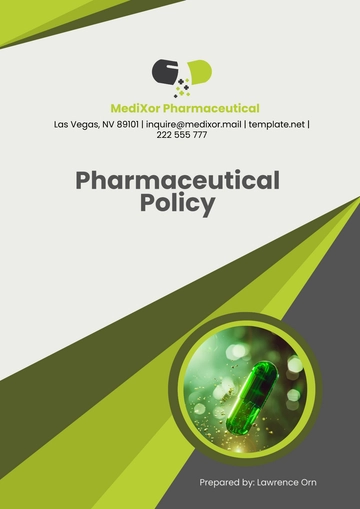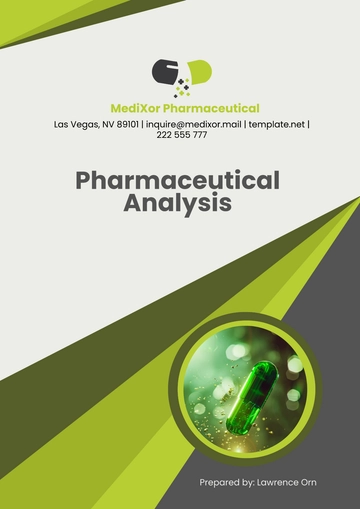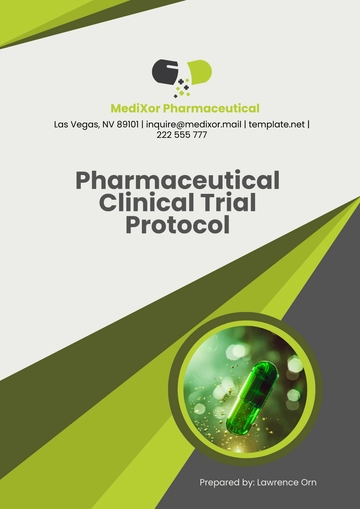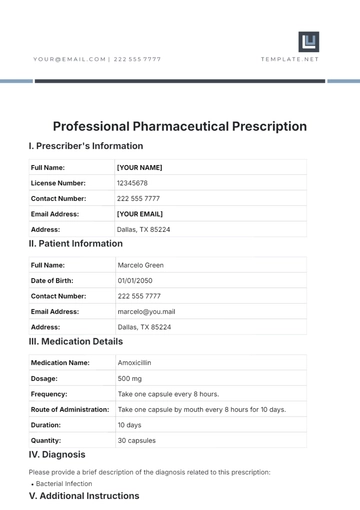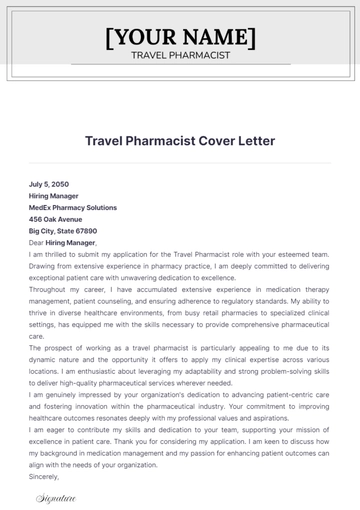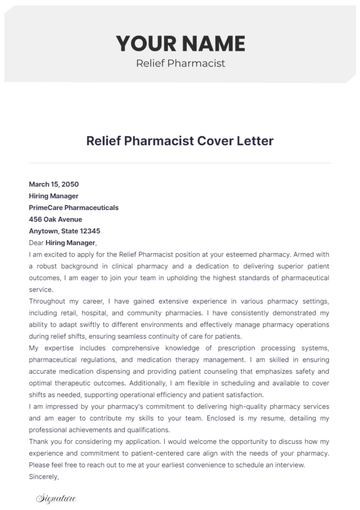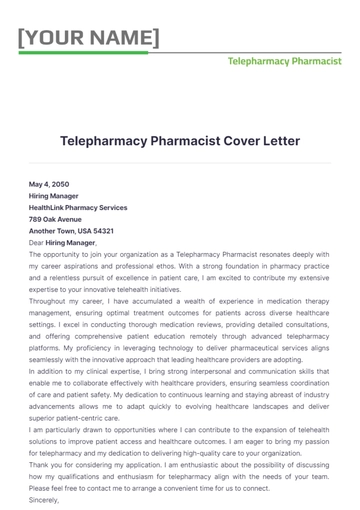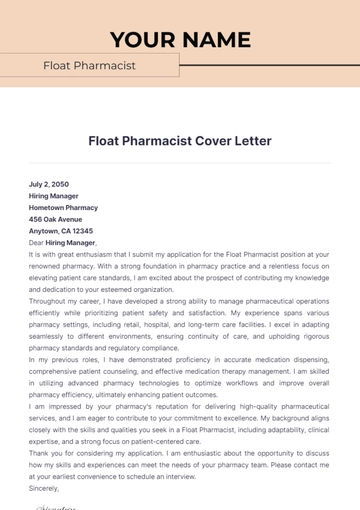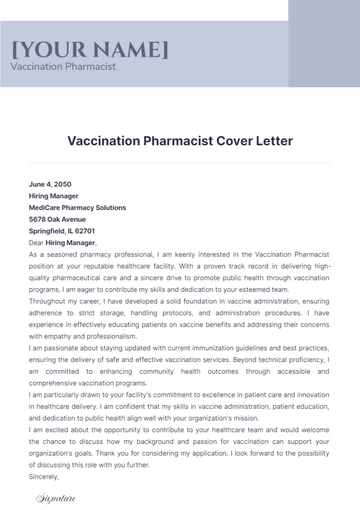Free Pharmaceutical Clinical Trial Protocol
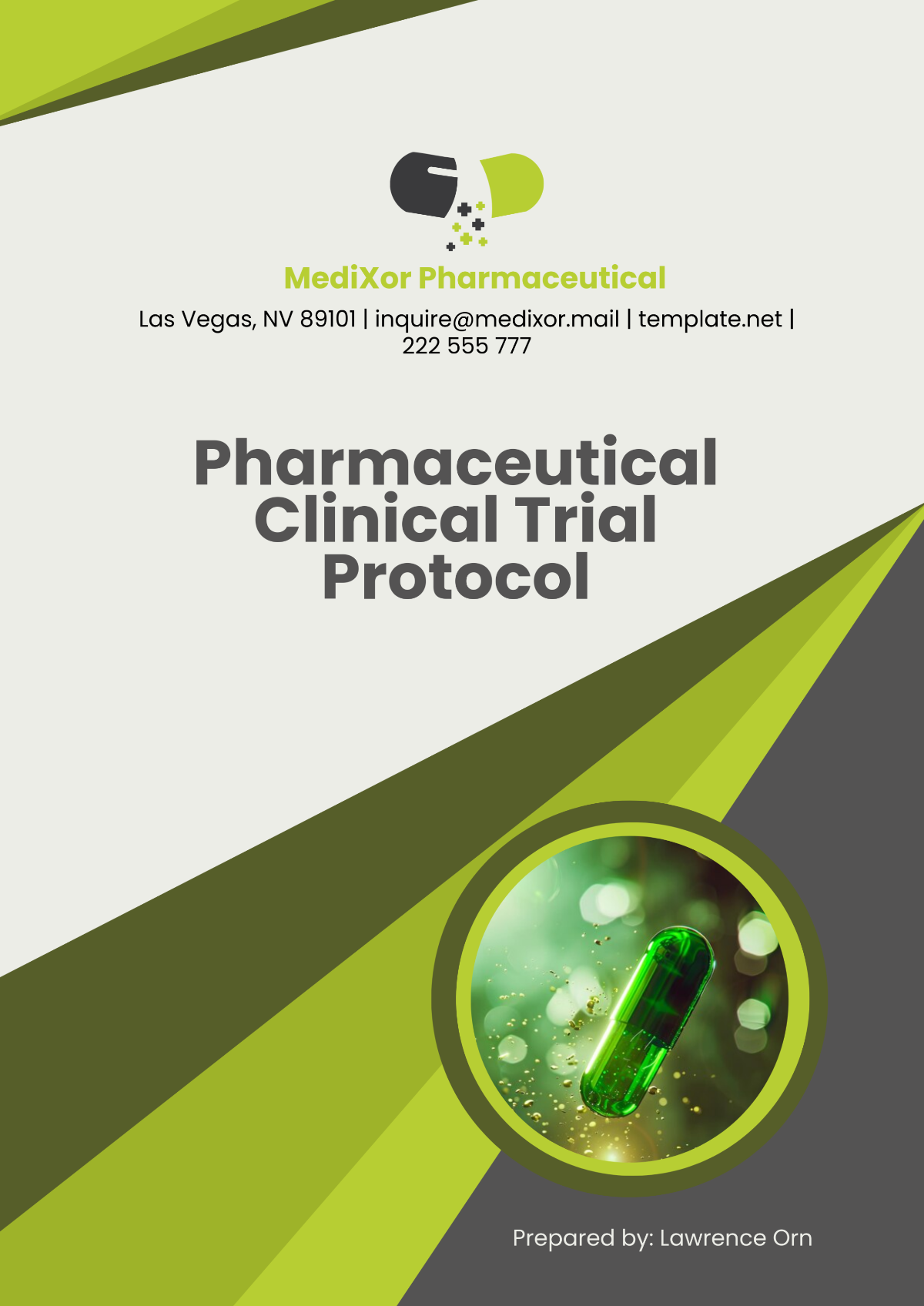
I. Study Synopsis
A. Study Phase
This clinical trial is a Phase III study designed to evaluate the efficacy, safety, and tolerability of the investigational product in a target population. Phase III studies aim to confirm therapeutic benefits and gather data required for regulatory approval.
B. Objectives and Purpose
The primary objective is to determine the efficacy of the investigational product in improving the clinical outcomes of participants. Secondary objectives include assessing the product's safety profile, tolerability, and impact on quality of life. This study seeks to address unmet medical needs in the targeted disease area.
C. Study Design Overview
This is a randomized, double-blind, placebo-controlled, multicenter trial with parallel groups. Participants will be stratified based on key baseline characteristics to ensure balanced group assignments. The trial includes an active treatment arm and a placebo arm.
D. Target Population
The study targets adult participants aged 18-75 years diagnosed with type 2 diabetes mellitus (T2DM) based on HbA1c levels [00]% and [00]% measured within the past 6 months, meeting defined inclusion and exclusion criteria. Subgroup analyses may focus on demographics, comorbidities, or other relevant characteristics.
E. Sample Size
Approximately 500 participants will be enrolled across multiple sites globally. This sample size is based on statistical calculations to detect clinically meaningful differences between treatment arms with adequate power and confidence.
F. Duration of the Study
The total study duration is 24 months, including:
Screening Period: Up to 4 weeks
Treatment Period: 12 months
Follow-Up Period: 6 months
G. Primary and Secondary Endpoints
Primary Endpoint
The primary endpoint of this study is the change in the [Disease Activity Score (DAS28)] from baseline to the end of the treatment period (12 months). This will assess the overall disease activity in participants with [rheumatoid arthritis], where a lower DAS28 score indicates reduced inflammation and improved clinical status. The primary analysis will focus on the difference in the mean change between the investigational product and placebo groups.
Secondary Endpoints
Time to Disease Progression: The secondary endpoint includes the time to progression of [joint damage] as assessed by [radiographic imaging]. Disease progression will be measured by changes in [modified Sharp Score or similar radiographic scoring systems].
Quality of Life: Improvement in quality of life will be assessed using the [Health Assessment Questionnaire – Disability Index (HAQ-DI)], with scores ranging from 0 (no disability) to 3 (severe disability). This will help evaluate the impact of the treatment on participants' functional status and daily living.
Safety Outcomes: The safety of the investigational product will be monitored by the incidence of adverse events (AEs), including serious adverse events (SAEs), throughout the study period. The safety analysis will focus on the types, frequencies, and severity of these events as well as any trends observed in laboratory and clinical tests (e.g., liver function, blood counts).
Patient-Reported Outcomes (PROs): The impact on participants’ symptoms will be measured using the [Visual Analog Scale (VAS)] for pain and the [Fatigue Severity Scale (FSS)]. These tools will quantify the self-reported severity of pain and fatigue, which are key factors affecting patients' daily functioning and quality of life.
Functional Capacity: The study will evaluate the change in the [6-Minute Walk Test (6MWT)], a measure of functional capacity and endurance, at baseline and after 12 months of treatment. This will help assess the overall physical health improvement and ability to perform daily activities.
II. Background and Rationale
A. Overview of the Disease or Condition
The target condition affects millions globally, leading to significant morbidity and mortality. Current standard-of-care treatments are often inadequate, addressing symptoms rather than the underlying disease mechanism. This study focuses on addressing the unmet medical need by introducing a therapeutic agent with a novel mechanism of action.
B. Investigational Product Description
The investigational product is a [monoclonal antibody] designed to specifically target [receptor]. It is administered via [route of administration] and is hypothesized to reduce disease activity based on preclinical models. Its unique pharmacological profile differentiates it from existing therapies, offering the potential for improved efficacy and safety.
C. Preclinical and Clinical Data Summary
Preclinical studies in animal models demonstrated significant improvements in [inflammation] with no significant safety concerns. Phase I trials confirmed the investigational product’s pharmacokinetics, optimal dosing, and tolerability in healthy volunteers. Phase II studies provided preliminary efficacy data, showing statistically significant improvements in primary endpoints compared to placebo.
D. Justification for the Study Design
The use of a randomized, double-blind, placebo-controlled design minimizes bias and provides robust evidence of efficacy and safety. Stratification by baseline characteristics ensures balanced groups and enhances the reliability of results. The study design aligns with regulatory requirements for obtaining marketing approval.
III. Study Objectives
A. Primary Objectives
The primary objective is to evaluate the efficacy of the investigational product in achieving [overall survival (OS)]. Efficacy will be assessed through validated tools and biomarkers directly linked to disease progression. Achieving this objective is critical for demonstrating the product's potential as a therapeutic option.
B. Secondary Objectives
Secondary objectives include assessing the safety profile of the investigational product by monitoring adverse events, laboratory values, and vital signs. Additional endpoints will evaluate improvements in patient-reported outcomes such as quality of life and functional status. These objectives aim to provide a comprehensive understanding of the product's clinical impact.
C. Exploratory Objectives
Exploratory objectives involve identifying potential biomarkers of response to the investigational product. This data may help predict which patient subgroups are most likely to benefit from treatment. Exploratory findings could guide future research and refine treatment strategies.
IV. Study Design and Methodology
A. Study Type
This randomized, double-blind, placebo-controlled trial is the gold standard for evaluating clinical interventions. Participants will be assigned to active or placebo groups in a 2:1 ratio to maximize safety and efficacy data collection. The multicenter approach ensures diversity in the study population, enhancing the generalizability of results.
B. Study Phases and Timeline
The study consists of a 4-week screening period, a 12-month treatment phase, and a 6-month follow-up phase. Regular interim analyses will assess safety and efficacy trends, ensuring participant welfare. This timeline balances thorough data collection with timely progress toward study goals.
C. Randomization and Blinding Procedures
Randomization will be conducted via a computer-generated system, stratified by key variables such as age and disease severity. Blinding will involve identical packaging for the investigational product and placebo to maintain study integrity. Emergency unblinding procedures will be in place but will only be used if necessary to ensure participant safety.
D. Study Flow Diagram
A detailed flow diagram outlining screening, randomization, treatment, and follow-up will be included. This visual representation ensures clarity for investigators, site staff, and regulatory authorities. It highlights critical decision points, such as participant withdrawals and interim safety evaluations.
V. Study Population
A. Inclusion Criteria
Participants must be aged 18-75 years with a confirmed diagnosis of type 2 diabetes mellitus (T2DM) based on HbA1c levels [00]% and [00]% measured within the past 6 months. They must have stable disease management with either lifestyle interventions or a consistent dose of oral antidiabetic medications for at least 12 weeks before screening. Written informed consent is required, ensuring participants understand the study's risks, benefits, and procedures, and confirming their voluntary participation.
B. Exclusion Criteria
Exclusion criteria include a history of hypersensitivity to the investigational product or its components. Participants with significant uncontrolled comorbidities or recent use of conflicting therapies will also be excluded. These criteria ensure participant safety and the validity of study results.
C. Recruitment Strategies
Participants will be recruited through clinical sites, patient registries, and community outreach programs. Online platforms and advocacy groups will be leveraged to enhance enrollment diversity. Recruitment efforts will include multilingual materials to reach underrepresented populations.
D. Participant Withdrawal Criteria
Participants may be withdrawn for reasons such as adverse events, protocol deviations, or personal requests. Withdrawal will involve detailed documentation to maintain data integrity and transparency. Efforts will be made to complete final assessments for withdrawn participants, when feasible.
VI. Study Procedures and Schedule
A. Screening Procedures
The screening phase will include informed consent, medical history review, and baseline testing such as laboratory assessments and imaging. This ensures participants meet eligibility criteria and establishes baseline measures for comparison. Comprehensive documentation during screening will reduce dropout rates during the trial.
B. Baseline Assessments
Baseline evaluations will include physical examinations, vital signs, and disease-specific scoring using validated tools. Biomarker levels and imaging studies will also be collected, providing reference points for efficacy and safety evaluations. These assessments are essential for identifying any pre-existing conditions that could affect outcomes.
C. Study Visit Schedule and Interventions
Participants will attend visits at defined intervals for drug administration, monitoring, and data collection. Visits will include assessments of compliance, efficacy endpoints, and safety parameters. The schedule is designed to minimize participant burden while ensuring robust data collection.
D. Laboratory and Diagnostic Testing
Laboratory tests will include complete blood counts, liver and kidney function tests, and disease-specific biomarkers. Diagnostic imaging may be performed at baseline, midpoint, and endpoint to assess disease progression. All tests will be conducted in accredited laboratories to ensure data accuracy.
E. Compliance Monitoring
Compliance will be tracked through participant diaries, electronic monitoring devices, and regular site visits. Non-compliance will be addressed through counseling and additional support, such as reminders. High compliance rates are critical for maintaining data reliability and integrity.
VII. Safety Monitoring and Adverse Event Reporting
A. Definitions of Adverse Events and Serious Adverse Events
Adverse events (AEs) are any unfavorable medical occurrences in participants, regardless of causality. Serious adverse events (SAEs) include life-threatening conditions, hospitalization, or death. A standardized grading system will classify events by severity and relation to the investigational product.
B. Safety Assessment Procedures
Safety monitoring will include periodic assessments of vital signs, laboratory results, and clinical symptoms. An independent Data Safety Monitoring Board (DSMB) will review safety data at scheduled intervals. Immediate measures will be implemented if safety concerns arise.
C. Reporting Requirements and Timelines
All AEs will be documented and reported to regulatory authorities within the required timeframe. SAEs will be reported within 24 hours, with detailed follow-up reports submitted subsequently. Transparent reporting ensures participant safety and regulatory compliance.
D. Risk Mitigation Strategies
Risk management includes careful participant selection, close monitoring, and predefined stopping criteria. Emergency protocols will be in place to address unexpected events. Regular investigator training will ensure prompt recognition and management of risks.
VIII. Statistical Considerations
A. Hypotheses and Statistical Design
The primary hypothesis is that the investigational product is superior to placebo in improving glycemic control, as measured by the change in HbA1c levels from baseline to the end of the treatment period (12 months). The statistical design incorporates stratification by baseline HbA1c levels and sensitivity analyses to account for potential confounders such as age, body mass index, and duration of diabetes. This approach ensures robust, reproducible results, providing clear evidence of the investigational product's efficacy in controlling blood sugar compared to placebo.
B. Sample Size Calculation and Rationale
The sample size of 500 participants provides [00]% power to detect a clinically meaningful difference with a [00]% significance level. Calculations account for potential dropout rates to maintain sufficient statistical power. This ensures the study can draw definitive conclusions.
C. Statistical Analysis Plan
Primary analyses will include intention-to-treat and per-protocol populations. Statistical methods such as ANCOVA or Kaplan-Meier will evaluate efficacy and time-to-event endpoints. Sensitivity analyses will address potential biases and confirm findings.
D. Methods for Handling Missing or Incomplete Data
Multiple imputation techniques will address missing data, preserving the integrity of statistical analyses. Sensitivity analyses will test the robustness of results under different assumptions about missing data. Clear documentation of missing data will ensure transparency.
IX. Ethical and Regulatory Considerations
A. Informed Consent Process
Participants will receive detailed information about the study, including potential risks and benefits. Consent will be obtained in their preferred language and confirmed through a signed document. Participants may withdraw consent at any time without penalty.
B. Institutional Review Board/Ethics Committee Approvals
The study protocol will be reviewed and approved by independent ethics committees at all participating sites. Any amendments to the protocol will undergo additional review to maintain ethical compliance. Regular updates will be provided to these committees as required.
C. Compliance with Good Clinical Practice (GCP) and Regulatory Standards
The trial will adhere to ICH-GCP guidelines and comply with regulatory requirements in each country. Investigator training will ensure understanding and implementation of these standards. Audits may be conducted to verify compliance.
D. Risk-Benefit Assessment
The potential benefits of the investigational product outweigh the anticipated risks based on preclinical and early-phase data. Risk mitigation strategies are in place to minimize participant exposure to harm. Regular safety reviews will monitor the ongoing risk-benefit profile.
E. Participant Privacy and Data Confidentiality
The study will implement strict data management protocols to ensure participant confidentiality and compliance with data protection regulations. Data will be de-identified before analysis to protect personal identifiers, with access limited to those directly involved in the study. Regular audits will be conducted to ensure adherence to privacy policies, and any potential data breaches will be immediately reported to the relevant authorities.
- 100% Customizable, free editor
- Access 1 Million+ Templates, photo’s & graphics
- Download or share as a template
- Click and replace photos, graphics, text, backgrounds
- Resize, crop, AI write & more
- Access advanced editor
Ensure a streamlined clinical trial process with the Pharmaceutical Clinical Trial Protocol Template from Template.net. This editable and customizable template empowers researchers to efficiently create comprehensive, tailored protocols. Featuring an intuitive AI Editor Tool, it simplifies document customization, saving time and ensuring compliance with regulatory standards, while offering flexibility for various clinical study designs.
